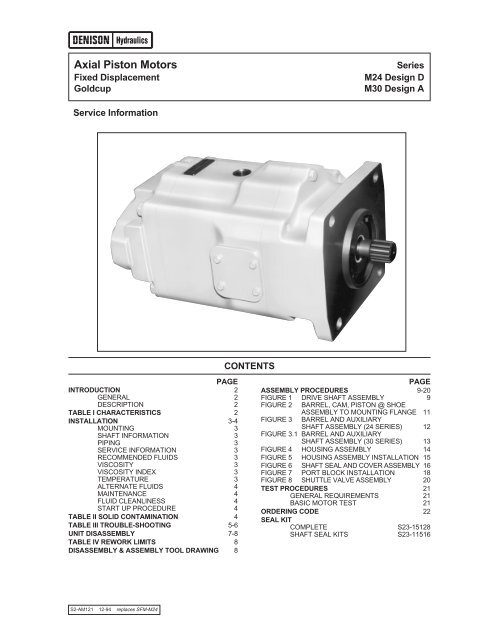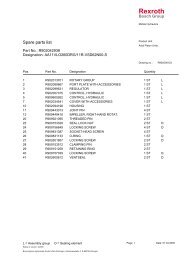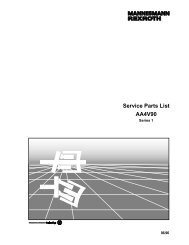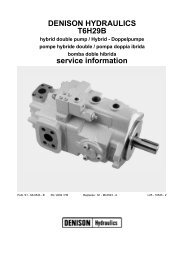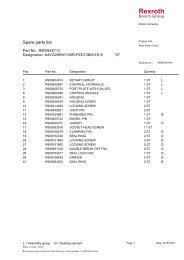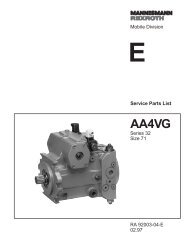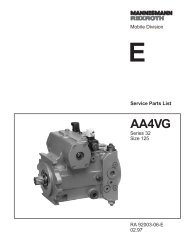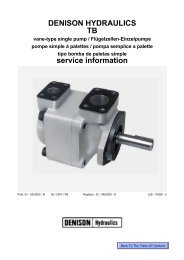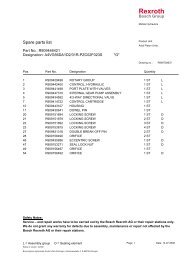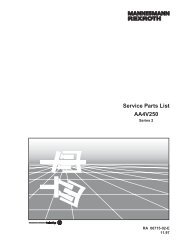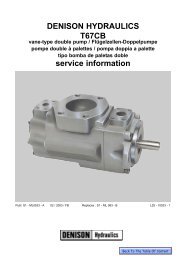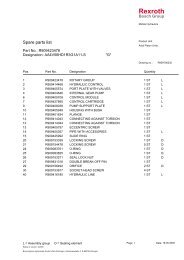S2-AM121 - DDKS Industries, hydraulic components distributor
S2-AM121 - DDKS Industries, hydraulic components distributor
S2-AM121 - DDKS Industries, hydraulic components distributor
You also want an ePaper? Increase the reach of your titles
YUMPU automatically turns print PDFs into web optimized ePapers that Google loves.
Axial Piston Motors<br />
Fixed Displacement<br />
Goldcup<br />
Series<br />
M24 Design D<br />
M30 Design A<br />
Service Information<br />
CONTENTS<br />
PAGE<br />
INTRODUCTION 2<br />
GENERAL 2<br />
DESCRIPTION 2<br />
TABLE I CHARACTERISTICS 2<br />
INSTALLATION 3-4<br />
MOUNTING 3<br />
SHAFT INFORMATION 3<br />
PIPING 3<br />
SERVICE INFORMATION 3<br />
RECOMMENDED FLUIDS 3<br />
VISCOSITY 3<br />
VISCOSITY INDEX 3<br />
TEMPERATURE 3<br />
ALTERNATE FLUIDS 4<br />
MAINTENANCE 4<br />
FLUID CLEANLINESS 4<br />
START UP PROCEDURE 4<br />
TABLE II SOLID CONTAMINATION 4<br />
TABLE III TROUBLE-SHOOTING 5-6<br />
UNIT DISASSEMBLY 7-8<br />
TABLE IV REWORK LIMITS 8<br />
DISASSEMBLY & ASSEMBLY TOOL DRAWING 8<br />
PAGE<br />
ASSEMBLY PROCEDURES 9-20<br />
FIGURE 1 DRIVE SHAFT ASSEMBLY 9<br />
FIGURE 2 BARREL, CAM, PISTON @ SHOE<br />
FIGURE 3<br />
ASSEMBLY TO MOUNTING FLANGE 11<br />
BARREL AND AUXILIARY<br />
SHAFT ASSEMBLY (24 SERIES) 12<br />
FIGURE 3.1 BARREL AND AUXILIARY<br />
SHAFT ASSEMBLY (30 SERIES) 13<br />
FIGURE 4 HOUSING ASSEMBLY 14<br />
FIGURE 5 HOUSING ASSEMBLY INSTALLATION 15<br />
FIGURE 6 SHAFT SEAL AND COVER ASSEMBLY 16<br />
FIGURE 7 PORT BLOCK INSTALLATION 18<br />
FIGURE 8 SHUTTLE VALVE ASSEMBLY 20<br />
TEST PROCEDURES 21<br />
GENERAL REQUIREMENTS 21<br />
BASIC MOTOR TEST 21<br />
ORDERING CODE 22<br />
SEAL KIT<br />
COMPLETE <strong>S2</strong>3-15128<br />
SHAFT SEAL KITS <strong>S2</strong>3-11516<br />
<strong>S2</strong>-<strong>AM121</strong> 12-94 replaces SFM-M24
Introduction Series 24, 30<br />
General<br />
This manual contains installation, operation, maintenance<br />
and overhaul instructions for Denison Hydraulics Goldcup<br />
24 and Goldcup 30 constant volume motors. The Denison<br />
Hydraulics Goldcup 24 and Goldcup 30 axial piston motors<br />
feature advance design concepts which are time proven<br />
and provide for advance pumping and control concepts.<br />
The instructions contained in this manual cover complete<br />
disassembly and reassembly of the unit. Before proceeding<br />
with the disassembly or reassembly of any unit, this<br />
manual should be studied in order to become familiar with<br />
proper order and parts nomenclature.<br />
Description<br />
The Goldcup motor is a fixed displacement, axial piston<br />
design which uses hydrostatically balanced piston shoes.<br />
This feature serves to lubricate as well as absorb much<br />
of the force generated by the shoes pressing against the<br />
cam, thereby increasing service life of the unit. Rotation<br />
of the unit is bi-directional.<br />
TABLE I TYPICAL CHARACTERISTICS<br />
Specification Term Goldcup 24 Goldcup 30<br />
Displacement in. 3 /rev 24.6 30.6<br />
cm 3 /rev (403) (501.4)<br />
Pressure Ports A & B max. continuous psi 5000 5000<br />
bar (345) (345)<br />
max. intermittent psi 5000 5000<br />
bar (345) (345)<br />
Speed, max. continuous @ full stroke RPM 2100* 1800<br />
Flow, Ports A or B GPM @ 2100 RPM 223.6 @ 1800 RPM 238<br />
(theoretical) L/min. (846) (901)<br />
Rotary Inertia lb/in 2 818 974<br />
kg/m 2 (0.239) (0.285)<br />
Torque, Theoretical in/lb 392 487<br />
per 100 PSI (6.9 bar) N•m (43) (55)<br />
at 5000 PSI (345 bar) in/lb 19576 24351<br />
N•m (2158) (2752)<br />
Power, Theoretical @ 5000 PSI (345 bar) hp 31.1 38.64<br />
at 100 RPM kW (23.1) (28.8)<br />
Power, Theoretical at 5000 PSI (345 bar) hp 621.3 695**<br />
at Max. RPM kW (463.5) (518)**<br />
Torque Efficiency approx. stalled % theoretical 81 81<br />
running % theoretical 93 93<br />
Mounting-4 bolt flange SAE F F<br />
Shaft-Spline / Keyed SAE F F<br />
Fluid Connection Ports A & B in 2 2<br />
SAE-4 bolt pad for 6000 psi split flange mm (50.8) (50.8)<br />
(414 bar)<br />
Weight lbs. 640 660<br />
kg. (290) (300)<br />
*On R & O Oils (Rust and Oxidation Inhibitor)<br />
** @ 1800 RPM<br />
2
Installation Series 24, 30<br />
Mounting<br />
This motor is designed to operate in any position. The<br />
mounting hub and four bolt mounting flange are in full conformance<br />
with SAE standard. The motor shaft must be in<br />
alignment with the shaft of the driven load and should be<br />
checked with a dial indicator. The mounting pad or adaptor<br />
into which the fluid motor pilots must be concentric with<br />
the motor shaft to prevent bearing failure. This concentricity<br />
is particularly important if the shaft is rigidly connected<br />
to the driven load without a flexible coupling.<br />
Shaft Information<br />
Splined: The shafts will accept a maximum misalignment<br />
of 0.006" TIR (.15 mm). Angular misalignment at the male<br />
and female spline axes must be less than ±.002 (0.05<br />
mm) per one inch radius. The coupling interface must be<br />
lubricated. Denison Hydraulics recommends lithium<br />
molydisulfate or similar grease. The female coupling<br />
should be hardened to 45-50 Rc and must conform to<br />
SAE-J498B (1971) Class 1 flat root side fit.<br />
Keyed: High strength heat treated keys must be used.<br />
Replacement keys must be hardened to 27-34 Rc. The key<br />
corners must be chamfered .030"-.040" (.75-1 mm) at 45°<br />
to clear radii that exist in the keyway.<br />
Keyed types of shafts will accept a side load of 1000 lbs.<br />
(454 kg) at the center of the key, with a B10 life of 9,880<br />
hours at 1800 RPM or 11,856 hours at 1500 RPM.<br />
NOTE: Do not impact coupling to force it onto the<br />
shaft.<br />
Piping<br />
Connect inlet and outlet lines to the port block of the motor.<br />
The fluid connections are:<br />
System Ports: 2" (50.8 mm)<br />
6000 PSI (414 bar), SAE<br />
4 bolt flange<br />
Other: SAE straight thread, O-ring seal.<br />
See installation drawing for sizes.<br />
The maximum case pressure is 75 PSI (5.17 bar) continuous,125<br />
PSI (8.6 bar) intermittent.<br />
NOTE: High case pressure will result in reduced B-<br />
10 life of the shaft bearing.<br />
It is recommended that the case leakage line be connected<br />
to the port located between the two system ports on the<br />
port block, but it may be connected to the top or bottom<br />
connections on the motor housing.<br />
The case leakage line must be of sufficient size to prevent<br />
back pressure in excess of 75 PSI (5.7 bar) and returned<br />
to the reservoir below the surface of the oil as far from the<br />
supply suction as possible. All fluid lines, whether pipe, tubing,<br />
or hose must be adequate size to assure free flow<br />
through the motor. We recommend 20 ft (6.09 M) max. per<br />
second for main flow and 6 ft. (1.8 M) max. limit per second<br />
for drain lines. Pressure rating of piping hose must be<br />
adequate for service duty required.<br />
An undersized outline line will create back pressure and<br />
cause improper operation. Flexible hose lines are recommended.<br />
If rigid piping is used, the workmanship must be<br />
accurate to eliminate strain on the port block or to the fluid<br />
connections. Sharp bends in the lines must be eliminated<br />
wherever possible. All system piping must be cleaned with<br />
solvent or equivalent before installing motor. Make sure the<br />
entire <strong>hydraulic</strong> system is free of dirt, lint, scale, or other<br />
foreign material. Flushing with a large temporary high pressure<br />
loop filter is recommended.<br />
CAUTION: Do not use galvanized pipe. Galvanized<br />
coating can flake off with continued use.<br />
Service Information<br />
These <strong>hydraulic</strong> products are designed to give long<br />
dependable service when properly applied and their systems<br />
properly maintained. These general instructions apply<br />
to typical systems. Specific instructions for particular equipment<br />
can be developed from them.<br />
Recommended Fluids<br />
The fluid recommended for use in these pumps and motors<br />
has a petroleum base and contains agents which provide<br />
oxidation inhibition and anti-rust, anti-foam and de-aerating<br />
properties as described in Denison Hydraulics standard<br />
HF-1. Where anti-wear additive fluids are specified, see<br />
Denison Hydraulics standard HF-0.<br />
Viscosity:<br />
Max. at cold start—7500 SUS (1600 Cst)<br />
(at low pressure, low speed)<br />
Max. at full power—750 SUS (160 Cst)<br />
Optimum for max. life—140 SUS (30 Cst)<br />
Minimum at full power—60 SUS (10 Cst)<br />
Viscosity Index:<br />
90 V.I. minimum. Higher values extend the range of operating<br />
temperature but may reduce the service life of the<br />
fluid.<br />
Temperature<br />
Determined by the viscosity characteristics of the fluid<br />
used. Because high temperatures degrade seals, reduce<br />
the service life of the fluid and create hazards, fluid temperatures<br />
should not exceed 180°F (82°C) at the case<br />
drain.<br />
3
Installation Continued Series 24, 30<br />
Alternate Fluids<br />
Some applications require fire-resistant fluids. They will<br />
give good service if the system is originally designed for<br />
their use. Permissible fire resistant fluids include:<br />
Type<br />
Denison Hydraulics Standard<br />
Water-in-oil invert emulsions<br />
HF-3<br />
Water glycol solutions<br />
HF-4<br />
Phosphate esters<br />
HF-5<br />
Consult Denison Hydraulics for design requirements and<br />
warranty limitations for service with this class of fluids.<br />
See Denison Hydraulics bulletin SPO-AM305 for more information.<br />
Maintenance<br />
This motor is self-lubricating and preventative maintenance<br />
is limited to keeping system fluid clean by changing filters<br />
frequently. Keep all fittings and screws tight. Do not operate<br />
at pressures and speeds in excess of the recommended<br />
limit. If the motor does not operate properly, check the<br />
Trouble Shooting Chart before attempting to overhaul the<br />
unit. Overhauling is relatively simple and may be accomplished<br />
by referring to the Disassembly, Rework Limits of<br />
Wear Parts and Assembly Procedures.<br />
Fluid Cleanliness<br />
Fluid must be cleaned before and continuously during operation<br />
by filters that maintain a cleanliness level of NAS 1638<br />
Class 8. This approximately corresponds to ISO 17/14.<br />
This fluid level cleanliness can usually be accomplished by<br />
the effective use of 10 micron filters. Better cleanliness levels<br />
will significantly extend the life of the <strong>components</strong>. As<br />
contaminant generation may vary with each application,<br />
each must be analyzed to determine proper filtration to<br />
maintain the required cleanliness level.<br />
2. Check alignment of drive.<br />
3. Visually inspect <strong>components</strong> and lines for possible<br />
damage.<br />
4. Check reservoir for cleanliness and clean as required.<br />
White glove test on all internal surfaces is recommended.<br />
5. Check fluid level and fill as required with filtered fluid at<br />
least as clean as that recommended. Fill motor case with<br />
clean oil prior to starting.<br />
6. Check oil cooler and activate it, if included in circuit.<br />
Check fluid temperature.<br />
7. Reduce pressure settings of pressure control. Make<br />
sure accurate pressure readings can be made at appropriate<br />
places.<br />
8. If solenoids in system, check for actuation.<br />
9. Start pump drive first by jogging prime mover. Make sure<br />
pump and motor fill properly.<br />
10. Bleed system of air. Recheck fluid level.<br />
11. Cycle unloaded machine at low pressure and observe<br />
actuation (at low speed, if possible).<br />
12. Increase pressure settings gradually in steps. Check<br />
for leaks in all lines especially in pump and motor inlet lines.<br />
13. Make correct pressure adjustments.<br />
14. Gradually increase speed. Be alert for trouble as indicated<br />
by changes in sounds, system shocks and air in fluid.<br />
Inspect oil surface with a good light while in operation. There<br />
must be no surface broken with oil surges and limit surface<br />
air bubbles to occasional.<br />
15. Equipment is operational.<br />
Start Up Procedure for New Installation<br />
1. Read and understand the instruction manual. Identify<br />
<strong>components</strong> and their functions.<br />
TABLE II<br />
COMPARISON OF SOLID CONTAMINATION CLASSIFICATION SYSTEMS<br />
NATIONAL AEROSPACE STANDARD (NAS) 1638<br />
4
Table III Trouble-shooting Chart Series 24, 30<br />
Trouble-Shooting<br />
Component problems and circuit problems are often interrelated.<br />
An improper circuit may operate with apparent success<br />
but will cause failure of a particular component within<br />
it. The component failure is the effect, not the cause of<br />
the problem.<br />
This general guide is offered to help in locating and eliminating<br />
the cause of problems by studying their effects:<br />
Effect of Trouble Possible Cause Fault Which Needs Remedy<br />
Noisy Motor Air in Fluid Leak in suction line<br />
Leak at shaft seal<br />
Low fluid level<br />
Turbulent fluid<br />
Return lines above fluid level<br />
Gas leak from accumulator<br />
Excessive pressure drop in the inlet line<br />
from a pressurized reservoir<br />
Suction line strainer acting as air trap<br />
Cavitation in motor<br />
rotating group<br />
Misaligned shaft<br />
Fluid too cold<br />
Fluid too viscous<br />
Fluid too heavy<br />
Shaft speed too high<br />
Suction line too small<br />
Suction line collapsed<br />
Operating altitude too high<br />
Boost or replenishment pressure too low<br />
Replenishment flow too small for<br />
dynamic conditions<br />
Faulty installation<br />
Distortion in mounting<br />
Axial interference<br />
Faulty coupling<br />
Excessive overhung loads<br />
Mechanical fault in motor Piston and shoe looseness or failure<br />
Bearing failure<br />
Incorrect port plate selection or index<br />
Erosion on barrel ports and port plate Air in fluid See above<br />
Cavitation<br />
See above<br />
High wear in motor Excessive loads Reduce pressure settings<br />
Reduce speeds<br />
Contaminant particles in fluid Improper filter maintenance<br />
Filters too coarse<br />
Introduction of dirty fluid to system<br />
Reservoir openings<br />
Improper reservoir breather<br />
Improper line replacement<br />
Improper fluid<br />
Fluid too thin or thick for operating<br />
temperature range<br />
Breakdown of fluid with<br />
time/temperature/shearing effects<br />
Incorrect additives in new fluid<br />
Destruction of additive effectiveness with<br />
chemical aging<br />
Improper repair<br />
Incorrect parts<br />
Incorrect procedures, dimensions, finishes<br />
(Continued)<br />
5
Table III Continued Series 24, 30<br />
Effect of Trouble Possible Cause Fault Which Needs Remedy<br />
High Wear in motor Unwanted water in fluid Condensation<br />
Faulty breather/strainer<br />
Heat exchanger leakage<br />
Faulty clean-up, practice<br />
Water in makeup fluid<br />
Pressure shocks Cogging load Mechanical considerations<br />
Worn relief valve<br />
Needed repairs<br />
Worn compensator<br />
Needed repairs<br />
Slow response in check valves Replace or relocate<br />
Excessive decompression Improve decompression control<br />
energy rates<br />
Excessive line capacitance Reduce line size or lengths.<br />
(line volume, line stretch, Eliminate hose<br />
accumulator effects)<br />
Barrel blow-off<br />
Recheck hold-down, rotating group,<br />
drain pressure<br />
Heating of fluid Excessive motor leakage Recheck case drain flow and repair as<br />
required<br />
Fluid too thin<br />
Improper assembly, port timing<br />
Relief valve<br />
Heat exchanger<br />
Reservoir<br />
Set too low (compared to load or to compensator)<br />
Instability caused by back pressure,<br />
worn parts<br />
Water turned off or too little flow<br />
Water too hot<br />
Fan clogged or restricted<br />
Efficiency reduced by mud or scale deposits<br />
Intermittent <strong>hydraulic</strong> fluid flow<br />
Too little fluid<br />
Entrained air in fluid<br />
Improper baffles<br />
Insulating air blanket that prevents<br />
heat rejection<br />
Heat pickup from adjacent equipment<br />
6
Unit Disassembly Series 24, 30<br />
Disassembly<br />
The instructions contained in this section cover a complete<br />
teardown of the subject motor. Disassemble only as far as<br />
necessary to replace or repair any worn parts. A bench or<br />
similar suitable surface capable of supporting unit should<br />
be used. Disassembly area should be clean.<br />
CAUTION: On 24 Series units relax barrel holddown<br />
prior to removal of shaft seal or main shaft. Failure to<br />
follow this procedure may result in motor failure.<br />
NOTE: The four main assembly bolts (1, Figure 9) are<br />
torqued to 450 ft. lbs. (610 N•m) These bolts should<br />
be loosened prior to removing unit for disassembly.<br />
Shuttle Valve Assembly<br />
See Figure 7<br />
1. Remove three screws (13) and remove valve assembly<br />
from port block.<br />
24 Series Barrel Holddown<br />
See Figure 3<br />
1. Remove holddown lock retainer ring (8, Figure 3). (Use<br />
internal snap ring pliers.)<br />
2. Remove four screws (1, Figure 7) and two screws (8,<br />
Figure 7).<br />
NOTE: There is a preload from the barrel holddown<br />
which will lift the port block approx. 1 ⁄8" at release.<br />
3. Carefully lift and remove port block (2) and port plate (4,<br />
Figure 7).<br />
CAUTION: The port plate may cling to the barrel<br />
face because of oil film. Do not allow the port plate<br />
to fall and become damaged.<br />
4. Remove the face plate and face plate pins (2, 1, Figure<br />
5) from the face of the barrel assembly.<br />
5. Remove holddown adjusting screw lock (7, Figure 3).<br />
6. Lock main shaft (1, Figure 6) from turning. Use special<br />
tool T2, slip over auxiliary shaft (2, Figure 3) and engage<br />
dowels into holddown adjusting screw (6, Figure 3). Loosen<br />
load but do not remove.<br />
7. Remove two bolts (8, Figure 7) holding housing and<br />
flange together.<br />
8. Barrel assembly can be removed by lifting with aux.<br />
shaft. The pistons will remain with the cam assembly.<br />
These parts are precision finished and must be handled<br />
with extreme care!<br />
9. Using special tool T2, holddown assembly can be<br />
removed from barrel. Remove adjusting screw (6, Figure<br />
3), spring (5), retainer (4), spherical seat (3) and auxiliary<br />
shaft (2).<br />
30 Series Barrel Holddown<br />
See Figure 3.1<br />
1. Remove four screws (1, Figure 7) and two screws<br />
(8, Figure 7).<br />
NOTE: There is a preload from the barrel holddown<br />
which will lift the port block approx. 1 ⁄8" at release.<br />
2. Carefully lift and remove port block (2) and port plate<br />
(4, Figure 7).<br />
CAUTION: The port plate may cling to the barrel<br />
face because of oil film. Do not allow the port plate<br />
to fall and become damaged.<br />
3. Remove the face plate and face plate pins (2, 1, Figure<br />
5) from the face of the barrel assembly.<br />
4. Loosen six screws gradually in alternating sequence.<br />
CAUTION: Holddown is under preload. Do not remove<br />
screws completely.<br />
5. Insert three #10-32 screws into the three #10-32 tapped<br />
holes. Alternately turn in screws till tapered retainer releases.<br />
A loud crack sound should be heard when it releases.<br />
6. Lock main shaft (1, Figure 6) from turning. Use special<br />
tool T2, slip over auxiliary shaft (2, Figure 3.1) and engage<br />
dowels into holddown adjusting screw retainer (6, Figure<br />
3.1). Loosen load but do not remove.<br />
7. Remove two bolts (8, Figure 7) holding housing and<br />
flange together.<br />
NOTE: Do not damage gasket faces in process. Do<br />
not remove the retaining screws or bearing from the<br />
housing unless bearing is damaged and replacement<br />
is necessary.<br />
8. Barrel assembly can be removed by lifting with auxiliary<br />
shaft. The pistons will remain with the cam assembly.<br />
These parts are precision finished and must be handled<br />
with extreme care!<br />
NOTE: Do not damage gasket faces in process. Do<br />
not remove the retaining screws or bearing from the<br />
housing unless bearing is damaged and replacement<br />
is necessary.<br />
7
Unit Disassembly Continued Series 24, 30<br />
TABLE IV Rework Limits of Wear Parts<br />
Max. Rework<br />
From Original<br />
Min. Dimension<br />
24 and 30 in 3 Dimension After Rework<br />
Port plate face .010" (.254 mm) .735" (18.67 mm)<br />
Shoe retainer face .005" (.127 mm) .494" (12.55 mm)<br />
*Piston shoe face (pocket) .002" (.051 mm)(24 in 3 ) .018" (.457 mm)(24in 3 )<br />
Creep plate face .010" (.254 mm) .365" (9.27 mm)<br />
Face plate None Replace<br />
* NO REWORK PERMITTED ON 30 in 3 SHOE.<br />
IMPORTANT:<br />
The port plate both sides, face finish must be 8 microinches, (0, 20 µmm) flat within .00006 (0, 0015) and parallel within<br />
.001 (0, 025 mm) T.I.R.<br />
The creep plate wear face finish must be 5 microinches (127 µmm), flat within .0005 (0, 012 mm) and parallel to the backside<br />
with .001 (0, 0254 mm) T.I.R.<br />
The shoe retainer wear face finish must be 32 microinches (813 µmm), and flat within .0005 (0, 012 mm) (must not be<br />
convex).<br />
The piston shoes wear face finish must be 30 microinches (760 µmm), and must be lapped in a set with the retainer plate,<br />
all shoe sole thicknesses to be within .001 (0, 0254 mm) after lapping. The maximum permissible shoe and piston axial<br />
looseness is .010 (0, 254 mm).<br />
The special retaining ring service kit (<strong>S2</strong>3-12629) may be required to control shoe holddown clearance.<br />
Drive Shaft<br />
See Figure 6<br />
1. Remove four screws (5), seal retainer (2), gaskets (4),<br />
and stationary part of shaft seal assembly (4). Refer to<br />
view of item 3.<br />
2. Remove the carbon ring and the remainder of the shaft<br />
seal from the shaft.<br />
3. Remove shaft and bearing assembly (1).<br />
Cam and Piston/Shoe Assembly<br />
1. Remove the retaining ring (2, figure 2), thrust washer<br />
(3), piston and shoe assembly (4) and creep plate (5) from<br />
the cam (6).<br />
2. Remove the cam from the mounting flange by carefully<br />
tilting mounting flange on its side and removing plugs (12,<br />
Figure 2) with O-rings (9, Figure 2) using 1 ⁄4-20 threaded<br />
rod as a puller, and removing screws (10, Figure 2) attaching<br />
cradle to mounting flange.<br />
Disassembly & Assembly Tool Drawings<br />
T1<br />
T2<br />
Removal & Replacement Tool for H.D. Lock Screw — Barrel H.D. Adjustment Tool<br />
8
Assembly Procedures Series 24, 30<br />
Drive Shaft Assembly<br />
Figure 1<br />
1. Slide the bearing (2) over the short end of the shaft and<br />
seat against the shoulder. Support only the inner race of<br />
the bearing and press on the long end of the shaft to install<br />
bearing.<br />
DO NOT USE EXCESSIVE FORCE. USE EXTREME<br />
CARE PASSING THE RING OVER THE SEAL SURFACE.<br />
2. Install the retaining ring (3) in the groove. Be sure that<br />
the ring is fully seated.<br />
FIGURE 1<br />
<strong>S2</strong>3-12474 #3 Drive Shaft Assembly (spline)<br />
<strong>S2</strong>3-12475 #2 Drive Shaft Assembly (w/keyway)<br />
QTY<br />
ITEM DESCRIPTION PART NO. #1 #2<br />
1 #3 (splined) Drive shaft 033-91139 1 —<br />
#2 (keyed) Drive shaft 033-91140 — 1<br />
2 Shaft bearing 230-82213 1 1<br />
3 Retaining ring 033-71712 1 1<br />
4 Square key 033-71910 — 1<br />
9
Assembly Procedures Continued Series 24, 30<br />
Barrel, Cam to Mounting Flange<br />
Figure 2<br />
3. Position the mounting flange (8) with the large open end<br />
facing up and install two dowel pins (7) in the cradle mounting<br />
surface and one-3/8" (9.52 mm) dia. dowel pin (11) in<br />
the outer edge of the flange.<br />
4. Install the cam (6) over the dowel pins (7) in the mounting<br />
flange. Position cam so that the thick part of the cam is<br />
on the same side as the 3/8" (9.52 mm) dowel (11).<br />
5. With cam installed, tilt mounting flange on its side and<br />
secure with two Soc. Hd. cap screws (10). Torque to 50 ft.-<br />
lbs. (67.8 N•m).<br />
6. Insert plugs (12) with o-rings (9) into Soc. Hd. cap screw<br />
(9) c'bores. Be sure tapped hole in plug (12) is visible after<br />
installation, this is used for removal.<br />
7 Install shaft and bearing assembly (1) Figure 6 (either<br />
splined or keyed as specified) by inserting shaft through<br />
bores, a few light taps are required on the bearing outer<br />
race to completely engage and seat bearing.<br />
NOTE: Do not tap on end of shaft.<br />
Seal Assembly<br />
Figure 6<br />
NOTE: See warning information below<br />
1. The shaft seal is available only as a complete assembly.<br />
Prior to installation examine all the seal parts. Handle<br />
the lapped seal seat and the carbon ring with extreme care.<br />
Both parts must be free of scratches, cracks or other damage.<br />
3. Install the spring (d) against the retainer.<br />
4. Apply oil to the inner surface of the rubber friction ring<br />
(f) and install the shell containing the friction and the carbon<br />
ring (c) over the shaft with the carbon ring exposed.<br />
5. Apply grease to the square section rubber seal (a) and<br />
install on the seat.<br />
6. Install the seat and seal in the seal retainer (2). The<br />
lapped surface of the seat must face the carbon ring.<br />
7. Install the seal retainer assembly and O-ring (4) over the<br />
shaft with the lapped surface against the carbon face.<br />
8. Install the screws (5) and the seal retainer.<br />
9. Depress the seal retainer only far enough to start the<br />
screws and tighten evenly in a criss-cross pattern. Torque<br />
to 30 ft.-lbs. (40.8 N•m).<br />
Seal Replacement<br />
Figure 6<br />
NOTE: 24 Series only–To replace shaft seal only.<br />
1. Remove unit for disassembly.<br />
2. Remove retaining ring (8, Fig. 3).<br />
3. Replace shaft seal. (Follow seal assembly in reverse<br />
order.)<br />
4. After seal is replaced re-install retaining ring (8, Fig. 3).<br />
CAUTION Failure to follow these instructions may result<br />
in pump failure.<br />
2. Install the spring retainer (e) over the shaft and against<br />
the bearing retaining ring.<br />
Mechanical shaft seal assembly procedure<br />
Warning: When installing a new mechanical shaft seal,<br />
exercise care to insure that all of the parts fit together properly.<br />
This is particularly important if the seal was once<br />
assembled and disassembled for some reason. If the rubber<br />
boot, item 4, grips the shaft and doesn't slide on the<br />
shaft, as it is disassembled, then the spring, item 7, can<br />
disengage the shell, item 5, from the band, item 6, so that<br />
they do not re-engage properly when reassembled. Be sure<br />
the shell and the band are properly engaged before<br />
reassembling the seal, and stays engaged during assembly.<br />
Note:<br />
Lubricate seal and shaft with clean <strong>hydraulic</strong> fluid of the<br />
same type that will be used in the system.<br />
10
Assembly Procedures Continued Series 24, 30<br />
Piston/Shoe Assembly to Cam<br />
Figure 2<br />
1. Return the mounting flange to an upright position.<br />
2. Install creep plate (5) over center post on cam (6) chamfered<br />
end first.<br />
3. Insert piston and shoes into retainer and install entire<br />
assembly (4) against creep plate.<br />
6. Position the barrel assembly (1) directly over the pistons.<br />
Starting with the uppermost piston, guide them one<br />
at a time into the barrel bores.<br />
NOTE: Support the barrel on the main shaft but tilted<br />
slightly so as not to allow the barrel to drop and fully<br />
engage the barrel and shaft splines, now the holddown<br />
assembly can be installed without any load against it.<br />
4. Install thrust washer (3), over center post of cam and<br />
against shoe retainer. Grooved side of washer must face<br />
shoe retainer.<br />
5. Install the thickest retaining ring (2) that will fit in the<br />
groove on the rocker cam center post which will allow a<br />
maximum clearance of .002-.005" (.05-.13 mm) between<br />
the creep plate and shoe faces. To check this clearance,<br />
grasp one piston and lift and lift until tight against shoe<br />
retainer. Insert thickness gage. If this clearance is not correct,<br />
select the appropriate retaining ring and repeat the<br />
checking procedure.<br />
NOTE: If metallic thickness gage is used, caution<br />
should be exercised not to scratch shoe face. There<br />
are five different retaining rings available for this tolerance.<br />
Each retaining ring is marked: .081/079"<br />
(2.06/2.01 mm) thick, blue dot; .083/.081" (2.11/2.06<br />
mm) thick, red dot; .087/.085" (2.21/2.16 mm) thick,<br />
green dot; .089/.087" (2.26/2.21 mm) thick, yellow<br />
dot; and .085-.083 (2.16/2.11mm) white dot. The piston<br />
and shoe assembly must be free to rotate 360°<br />
by hand.<br />
PARTS LIST FOR FIGURE 2<br />
ITEM DESCRIPTION PART NO. QTY.<br />
1 Barrel & aux. shaft assy. See Fig. 3 1<br />
2 Retaining ring — use one only 1<br />
.089/.087 thick w/yellow dot (2.26/2.21 mm) 033-71716<br />
.087/.085 thick w/green dot (2.21/2.16 mm) 033-71717<br />
.083/.081 thick w/red dot (2.11/2.06 mm) 033-71718<br />
.081/.079 thick w/blue dot (2.06/2.01 mm) 033-59746<br />
.085/.083 thick w/white dot (2.16/2.11 mm) 033-91130<br />
Retaining ring service kit <strong>S2</strong>3-12629<br />
3 Thrust washer 033-59805 1<br />
4 Piston & shoe assy. P24 S13-44470 1<br />
Piston & shoe assy. P30 <strong>S2</strong>3-12684<br />
5 Creep plate 033-71747 1<br />
6 Cam 033-91148 1<br />
7 Dowel pin 324-24028 2<br />
8 Mounting flange 033-91137 1<br />
9 O-ring 671-00111 2<br />
10 Soc. Hd. cap screw 358-16260 2<br />
11 Dowel pin 324-22416 1<br />
12 Plug 033-57475 2<br />
Figure 2<br />
11
Assembly Procedures Continued Series 24, 30<br />
Barrel and Auxiliary Shaft Assembly<br />
Figure 3 (24 Series)<br />
1. Install auxiliary shaft (2) large spline end first into counterbore<br />
in face of barrel and engage barrel spline.<br />
2. Install spherical seat (3) round or spherical face up into<br />
counterbore in face of barrel.<br />
4. Thread holddown adjustment screw (6) into counterbore<br />
approx. four threads.<br />
5. Tilt barrel vertically and engage main shaft spline with<br />
the barrel spline allowing barrel to drop in place.<br />
6. Thread holddown adjusting screw (6) into counterbore<br />
until it is flush to .060" (1.52 mm) max. below barrel face.<br />
3. Install spring retainer (4) socket side down into counterbore,<br />
install spring (5) and seat against spring retainer.<br />
PARTS LIST FOR FIGURE 3 (24 SERIES)<br />
QTY<br />
ITEM DESCRIPTION PART NO. P24P<br />
1 Barrel & sleeve assy. 24 series only <strong>S2</strong>3-12091 1<br />
2 Auxiliary drive shaft 033-57211 1<br />
3 Spherical seat 033-57147 2<br />
4 Spring retainer 033-57138 1<br />
5 Spring 033-57136 1<br />
6 Holddown adj. screw 033-57139 1<br />
7 Holddown adj. scr. lock 033-57241 1<br />
8 Holddown lock retaining ring 033-57239 1<br />
FIGURE 3<br />
12
Assembly Procedures Continued Series 24, 30<br />
Barrel and Auxiliary Shaft Assembly<br />
Figure 3.1 (30 Series)<br />
1. Install auxiliary shaft (2) spline end first into counterbore<br />
in face of barrel and engage barrel spline.<br />
2. Slide holddown spring assembly (see enlargement for<br />
proper spring arrangement) (3) onto shaft (2).<br />
3. Install spring retainer (4) into counterbore.<br />
4. Thread holddown screw assembly (5) into barrel’s counterbore<br />
approx. four threads.<br />
5. Tilt barrel vertically and engage main shaft spline with<br />
the barrel spline allowing barrel to drop in place.<br />
6. Thread holddown screw assembly (5) into counterbore<br />
until it is .25 (6.35 mm) below barrel face.<br />
PARTS LIST FOR FIGURE 3.1 (30 SERIES)<br />
QTY<br />
ITEM DESCRIPTION PART NO. P30P<br />
1 Barrel & sleeve assy. 30 series only <strong>S2</strong>3-12170 1<br />
2 Auxiliary drive shaft 033-57935 1<br />
3 Holddown spring 035-71713 8<br />
4 Spring retainer 033-91138 1<br />
5 Barrel holddown nut assy. <strong>S2</strong>3-12171 1<br />
FIGURE 3.1<br />
13
Assembly Procedures Continued Series 24, 30<br />
<strong>S2</strong>3-12566 (P24) P23-12175 (P30)<br />
Housing Assembly<br />
Figure 4<br />
1. Clean housing (1) and position on a flat surface with the<br />
large open end up.<br />
2. Apply Loctite primer grade “T” & Loctite retaining compound<br />
#609 per A.P. 01433 to bearing O.D. & bearing bore<br />
of housing. Immediately align & press bearing into housing<br />
bore with a smooth steady force until seated. Install<br />
socket head cap screw (3) with washer (7). Typical two<br />
places. Torque to 30 ft. lbs. (40.8 N•m).<br />
3. Install two dowel pins (4) in the blind holes in the control<br />
cover pads.<br />
4. Repeat step 3 on the opposite side of the housing.<br />
5. Install O-ring (5) and plug (6) in the bottom of housing.<br />
PARTS LIST FOR FIGURE 4<br />
ITEM DESCRIPTION PART NO. QTY.<br />
1 Housing (P24) 033-57150 1<br />
Housing (P30) 033-57925 1<br />
2 Bearing 033-91150 1<br />
3 Screw Soc Head Cap 358-14106 2<br />
5<br />
⁄16 x 18 x 5 ⁄8 w/Nylock<br />
4 Dowel pin 324-21608 4<br />
5 O-ring 691-00920 1<br />
6 Plug 488-35019 1<br />
7 Washer 11 ⁄32 (8.73 mm) 345-10020 2<br />
steel<br />
FIGURE 4<br />
14
Assembly Procedures Continued Series 24, 30<br />
Housing Assembly Installation<br />
Figure 5<br />
1. Install gasket (3) over the dowel pin in the mounting<br />
flange. Do not use gasket compound.<br />
2. Install the housing assembly (4) over the barrel and auxiliary<br />
shaft assembly.<br />
3. Insert two Hex. Hd. cap screws (5) through mounting<br />
flange and into housing. Torque to 100 ft.-lbs. (135.6 N•m).<br />
These must be fully torqued later when main bolts are in<br />
place.<br />
4. Install face plate pins (1) in the holes provided in the barrel<br />
face.<br />
5. Apply clean heavy grease to the surface of the barrel<br />
and install the face plate (2) over the face plate pins. The<br />
surfaces must be absolutely free of scratches, dust or dirt<br />
to prevent excessive leakage. Lubricate pistons with clean<br />
system fluid through the holes in the face plate.<br />
CAUTION: The face plate has a black break-in coating<br />
on top of bronze which is bonded to a steel backing.<br />
Lightly sand the edge of the plate to identify the<br />
bronze coated side. The bronze side should go toward<br />
the port plate.<br />
PARTS LIST FOR FIGURE 5<br />
ITEM DESCRIPTION PART NO. QTY.<br />
1 Face plate pins 033-59747 3<br />
2 Barrel face plate (P24) 033-71748 1<br />
Barrel face plate (P30) 033-57571 1<br />
3 Housing gasket 033-91082 1<br />
4 Housing assembly See Fig. 4 1<br />
5 Hex Hd. screws 306-40009 2<br />
FIGURE 5<br />
15
16<br />
PARTS LIST FOR FIGURE 6<br />
ITEM DESCRIPTION PART NO. QTY.<br />
1 No. 3 Splined shaft assy. <strong>S2</strong>3-12474 1<br />
(See fig. 1)<br />
No. 2 Keyed shaft assy. <strong>S2</strong>3-12475<br />
(See fig. 1)<br />
2 Seal retainer 033-57472<br />
3 Shaft seal 623-00015 1<br />
4 Seal retainer O-ring 671-00246 1<br />
5 Hex. head screw 306-40123 4<br />
6 Nyltite washer 631-45007 8<br />
7 Hex. hd. washer screw 353-25039 8<br />
8 Cover 033-53252 2<br />
9 Gasket 033-91058 2<br />
FIGURE 6<br />
Assembly Procedures Continued Series 24, 30
Assembly Procedures Continued Series 24, 30<br />
Port Block Installation<br />
Figure 7<br />
1. Position the motor with open end of the housing assembly<br />
(6) facing up. Install new gasket (5) on the housing. Do<br />
not use gasket compound.<br />
2. Install two port plate pins (3) in the face of the port block<br />
(2) and the dowel pins (7) into mounting surface of port<br />
block.<br />
3. Insert lifting eyes into tapped holes in each system port<br />
mounting surface.<br />
4. Apply heavy grease to the rear of the port plate (4) and<br />
install over the port plate pins.<br />
5. Temporarily attach port plate to port block by inserting<br />
a cord through one of the 2" (50.8 mm) dia. ports down<br />
through the port block port, around arcuate divider in port<br />
plate, back through port block and tie ends of the cord to<br />
lifting eye. Repeat this step to the other side of the port<br />
plate.<br />
6. Install the port block over the auxiliary shaft and position<br />
onto dowel pins.<br />
7. Install the six bolts (1 & 8) with washers (9, 10). Do not<br />
drop the bolts in place as the threads may be damaged.<br />
Torque bolts evenly. Torque bolts (1) in 50 lb. (67.8 N•m)<br />
increments to 450 ft.-lbs. (610 N•m) and the two bolts (8)<br />
to 120 ft.-lbs. (163 N•m) tightening in turn all six bolts.<br />
Re-torque the two bolts (5) Fig. 5 to 120 ft.-lbs (163 N•m).<br />
PARTS LIST FOR FIGURE 7<br />
ITEM DESCRIPTION PART NO. QTY.<br />
1 Hex head cap screw (P24P) 306-40221 4<br />
Hex head cap screw (P30P) 306-40230 4<br />
2 Port block 033-57898 1<br />
3 Port plate pins 324-21610 2<br />
4 Port plate (24) 033-71751 1<br />
Port plate (30) 033-91149 1<br />
5 Port block gasket 033-91085 1<br />
6 Housing assembly (24) <strong>S2</strong>3-12566 1<br />
Housing assembly (30) <strong>S2</strong>3-12175 1<br />
7 Dowel pin 033-57020 2<br />
8 Hex head cap screw 306-40022 2<br />
9 Washer, Hdn. St’l. 350-10136 2<br />
10 Washer, Hdn. St’l. 350-10135 4<br />
11 Seal/shuttle valve 691-10016 3<br />
Seal/cover 691-10014 2<br />
Seal/cover 691-10019 1<br />
12 Shuttle valve/2 orif. S13-48776 1<br />
Shuttle valve/Int. dr. S13-48273<br />
Cover 033-71649<br />
13 Screw-hex hd./shuttle 306-48273 3<br />
Screw-hex hd./cover 306-40071<br />
14 O-ring 671-00147 1<br />
15 End cover 033-72100 1<br />
16 Retaining ring 356-65082 1<br />
17 O-ring 691-00906 1<br />
18 Hex. soc. plug 488-35041 1<br />
19 O-ring 691-00920 1<br />
20 Plug 488-35019 1<br />
17
Assembly Procedures Continued Series 24, 30<br />
FIGURE 7<br />
18
Assembly Procedures Continued Series 24, 30<br />
Barrel Holddown<br />
Figure 3 & 7 (24 Series)<br />
1. Use special tool T2 and slip over auxiliary shaft and<br />
engage the holes in the holddown adjusting screw (6, figure<br />
3). Carefully tighten until screw bottoms out.<br />
NOTE: The main drive shaft must be held to prevent<br />
barrel assembly from turning. If barrel assembly turns,<br />
the adjustment cannot be made.<br />
2. Back off holddown screw assembly 140°, counter-clockwise.<br />
3. Barrel lift-off is now set at .032" (.81 mm).<br />
4. Remove spanner wrench. Rotate drive shaft, item 31, to<br />
check if any binding occurs.<br />
5. Lock holddown screw assembly in place by tightening<br />
the six socket head cap screws gradually in the following<br />
torque sequence until 65 in.-lbs. (7.4 N•m) torque is<br />
reached.<br />
2. Remove special tool T2 and sight through holddown screw<br />
and note where tooth of auxiliary shaft spline is located.<br />
3. Back off holddown screw (loosen) 5 to 6 spline teeth on<br />
auxiliary shaft (approx. 135°).<br />
NOTE: If barrel holddown has to be reset for any reason<br />
all six socket head cap screws must be loosened<br />
gradually in the same order they were tightened. Do<br />
not remove socket head screws completely. Use the<br />
#10-32 UNF tapped holes in the insert to disengage<br />
insert from holddown screw assembly. Insert must be<br />
loose before resetting barrel holddown.<br />
NOTE: Tapped hole in holddown screw must line up<br />
with space between spline teeth.<br />
4. Barrel lift-off is now set at .030-.036 (.76-.91 mm).<br />
5. Use special tool T1 and thread holddown adjusting screw<br />
lock (7, figure 3) into holddown adjusting screw. Torque to<br />
30 ft.-lbs. (40.7 N•m).<br />
6. Slip holddown lock retaining ring (8, figure 3) over auxiliary<br />
shaft into groove which is located 2 3 ⁄16" (55.2 mm) from<br />
end of shaft.<br />
7. Untie cords holding port plate and remove.<br />
Barrel Holddown<br />
Figure 3.1 & 7 (30 Series)<br />
1. Use special tool T2 and slip over auxiliary shaft<br />
and engage dowels into holddown screw assembly, (5,<br />
Figure 3.1). Carefully tighten clockwise until holddown<br />
screw assembly bottoms out.<br />
**Torque sequence for locking holddown screw assembly.<br />
6. Untie cords holding port plate and remove.<br />
End Cover<br />
Figure 7<br />
1. Apply a light film of oil or grease to O-ring (14) and place<br />
in groove in end cover (15). Insert end cover (15) into bore<br />
of port block.<br />
2. Install retaining ring (16) into groove.<br />
NOTE: The main drive shaft must be held to prevent<br />
barrel assembly from turning. If barrel assembly turns,<br />
the adjustment cannot be made.<br />
19
Shuttle Valve Assembly Series 24, 30<br />
Shuttle Valve Assembly Internal Drain<br />
1. Place valve assembly (12, fig. 7) in a horizontal position<br />
with the O-ring groove up.<br />
2. Press seat (11) in the .500" (12.7 mm) diameter bore<br />
until it is flush with the body surface.<br />
3. Install spring centering washer (4) over each end of<br />
spool.<br />
5. Install springs (3) over ends of spool and into sockets of<br />
centering washers.<br />
6. Lubricate O-rings (2) and install over plugs (1). Install<br />
the plugs over springs and into body.<br />
8. Install spring (9) in spool (10).<br />
9. Lubricate O-ring (8) and install on groove of plug (7) on<br />
internally drained shuttle.<br />
10. Install plug (7) over spring (9) and tighten.<br />
11. Install seal (11, fig. 7) in counterbore in center of shuttle<br />
valve assembly. Hold in place with a coating of grease.<br />
Install the two seals in remaining counterbores.<br />
12. Install orifices, (15) if required.<br />
13. Install the shuttle valve assembly on port block pad and<br />
secure with screws (13). Torque screws to 20 ft.-lbs. (27.2<br />
N•m)<br />
7. Install spool (10) in bore against seat (11).<br />
FIGURE 8<br />
S13-48273 Assembly, Shuttle Valve without orifices<br />
S13-48776 Assembly, Shuttle Valve with orifices<br />
Item Qty. Part No. Description<br />
1 2 488-35002 Plug<br />
2 2 691-00908 O-ring<br />
3 2 033-70515 Spring<br />
4 2 033-70495 Washer, spring centered<br />
5 1 033-70529 Spool<br />
6 1 033-53117 Body<br />
7 1 033-72129 Plug<br />
8 1 691-00906 O-ring<br />
Item Qty. Part No. Description<br />
9 1 033-71923 Spring, relief valve<br />
10 1 033-71925 Spool, relief valve<br />
11 1 033-53154 Seat<br />
12 3 691-10016 Tetraseal<br />
13 3 306-48273 Screws, 5/16-18 x 2 3/4<br />
14 2 345-20004 Shim washer<br />
15 2 033-53523 Orifice .78 (mm) (optional)<br />
20
Test Procedures Series 24, 30<br />
General Requirements<br />
1. Maximum runout between motor shaft and electric motor<br />
shaft .003 T.I.R.<br />
2. Electric motor speed—1800 RPM.<br />
3. Inlet temperature—130° ± 10°F. (54°C ± 4°C).<br />
4. Inlet condition—24 Series<br />
100 to 150 PSI.<br />
(6.9 to 10.3 bar)<br />
30 Series<br />
225 to 275 PSI.<br />
(15.5 to 19 bar)<br />
5. Case pressure 50 PSI ± 5 PSI. (3.4 ± .34 bar).<br />
6. Fluid—200SSU @ 100°F. (37.8°C).<br />
Basic Motor Test<br />
1. Mount motor on test stand. Connect system lines to<br />
motor. Fill case with clean oil. Dry all oil from motor to permit<br />
checking for external leaks.<br />
2. If motor contains a shuttle, replace the hex. plugs on the<br />
shuttle block with hex. socket plugs prior to running test.<br />
After checking leakage, replace plugs. Adjust system pressure<br />
for 1000 PSI (69 bar). Check and record system flow<br />
and case drain flow both directions of rotation. Monitor loop<br />
temperature.<br />
24 Series 30 Series<br />
Maximum System Flow<br />
194 GPM (734 l/m) 241 GPM (912 l/m)<br />
Maximum Case Drain Flow<br />
3 GPM (11.3 l/m) 4 GPM (15 l/m)<br />
3. Break in motor as follows: Run break in for both directions<br />
of rotation.<br />
10 minutes at 1000 PSI (69 bar)<br />
10 minutes at 2500 PSI (172 bar)<br />
10 minutes at 5000 PSI (345 bar)<br />
4. Adjust system pressure to 5000 PSI (345 bar). Check<br />
and record system flow and case drain flow both directions<br />
of rotation.<br />
24 30<br />
Minimum System Flow<br />
180 GPM (680 l/m) 220 GPM (833 l/m)<br />
Maximum Case Drain Flow<br />
5.0 GPM (19 l/m) 6 GPM (23 l/m)<br />
21
22<br />
Notes Series 24, 30
Ordering Code Series 24, 30<br />
M 24 G - 2 N 1 D - 00- M 2 - X X X X X<br />
Motor series<br />
Displacements, max<br />
24-24.6 in 3 /rev., 403 cc/rev.<br />
30-30.6 in 3 /rev., 501.4 cc/rev.<br />
F-Fixed w/o shuttle<br />
G-Fixed displ. w/ shuttle<br />
Designates special<br />
Shuttle Features<br />
M * G<br />
00-Without orifices<br />
02-With orifices<br />
Shaft<br />
SAE-F<br />
2-Keyed<br />
3-Splined<br />
Shaft rotation<br />
(viewed from shaft end)<br />
N-Bi-directional<br />
Fluid class<br />
1-compatible w/Buna N<br />
4-compatible w/EPR<br />
5-compatible w/Viton<br />
Design letter<br />
(assigned by manufacturer)<br />
23
SALES & SERVICE WORLDWIDE


